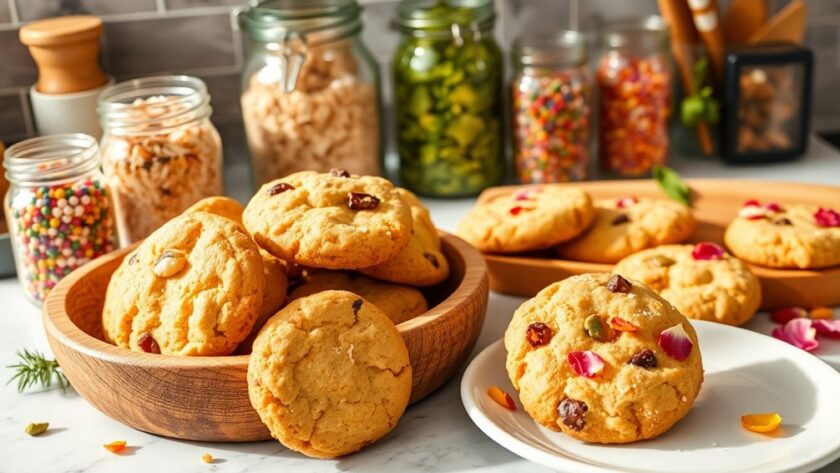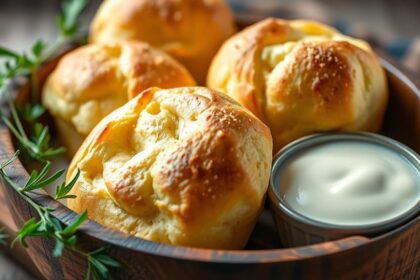You can make delicious cookies without chocolate chips by exploring alternative flavors. Start with a rich, buttery dough, using dark brown sugar for a caramel note. Add crunch with nuts like walnuts or pecans, and toss in dried fruits such as cranberries or apricots for natural sweetness. Spice things up with cinnamon or nutmeg. Experiment with toffee bits or butterscotch chips for a caramel twist. Don't forget to sprinkle flaky sea salt before baking to enhance all those flavors. Chill the dough to achieve that perfect chewy texture, and there's so much more to discover in crafting these treats!
Unique Features of Chipless Cookies
When you bite into a chipless cookie, you'll immediately notice its rich, buttery flavor, which is beautifully enhanced by dark brown sugar's caramel-like notes. The absence of chocolate chips allows the cookie's base flavor to shine through, making it an ideal choice for those who enjoy simpler, less sweet treats. These cookies can also incorporate nutty ingredients like almond flour, adding a gluten-free option that enhances both texture and flavor. Additionally, gluten-free flour can serve as a great foundation for your cookie base, ensuring a delicious end result.
To elevate the taste even further, consider sprinkling flaky salt on top before baking; it creates a delightful contrast to the sweetness of the sugars. Chilling the dough for about 20 minutes helps maintain a chewy cookie texture with crisp edges. Plus, you can easily customize these cookies with alternative mix-ins like nuts or dried fruit, giving you a variety of flavor experiences without chocolate. Additionally, using gluten-free flour options can enhance the texture and flavor profiles of your chipless cookies, making them suitable for those with dietary restrictions.
Essential Ingredients for Success
To make cookies without chocolate chips, you need to focus on a few essential ingredients for success.
The right combination of sugars and quality butter plays a vital role in achieving the perfect flavor and texture. Additionally, using almond extract infused adds a nutty undertone that can elevate your cookie's flavor profile. Almond flour provides a nutty flavor and soft texture, making it an excellent alternative to traditional flours.
Don't underestimate the importance of key dry ingredients like flour, as they set the foundation for your delicious treats. Additionally, incorporating nutrient-rich flours can enhance both the flavor and health benefits of your cookies.
Key Dry Ingredients
While crafting cookies without chocolate chips, the choice of dry ingredients plays a crucial role in determining their texture and flavor.
Start with all-purpose flour, as it provides the necessary structure and tender crumb. Measure it accurately by spooning and leveling to prevent excess.
Granulated sugar adds sweetness and contributes to a chewy texture, while dark brown sugar introduces rich caramel notes.
Don't forget baking soda; it acts as a leavening agent, promoting spread and creating that desirable crisp edge.
A pinch of fine salt enhances flavor, balancing sweetness and highlighting buttery notes.
For added moisture, consider mixing in cornstarch, which helps create a softer texture and prevents your cookies from becoming too flat.
Enjoy experimenting!
Role of Sugars
Sugars play an essential role in cookie making, influencing both flavor and texture. Using a combination of granulated sugar and dark brown sugar enhances the flavor depth, with brown sugar adding a rich, caramel-like taste thanks to its higher molasses content.
If you want chewy cookies, equal parts of these sugars are key, as they create that desired consistency. Brown sugar not only sweetens but also retains moisture, keeping your cookies soft for longer.
If you're out of dark brown sugar, light brown sugar can work, though it'll yield a milder flavor. Finally, adjusting your sugar amounts can greatly affect the outcome; reducing sugar a bit helps maintain a thicker cookie shape and prevents excessive spreading.
Importance of Butter
Butter is an essential ingredient in cookie making, as it directly impacts both flavor and texture.
Using unsalted butter gives you control over saltiness, enhancing the overall flavor balance. When you use room temperature butter, ideally softened for about an hour, it helps achieve a light and fluffy texture when creamed with sugars, which is vital for structure.
The fat content in butter contributes greatly to the chewiness of your cookies; recipes with both butter and an egg yolk yield a richer, denser texture. Melted butter creates a paste-like consistency, leading to fudgy centers that enhance the cookie's texture.
Just remember, while browning butter can add a nutty flavor, it requires careful attention to avoid dryness.
Step-by-Step Baking Instructions
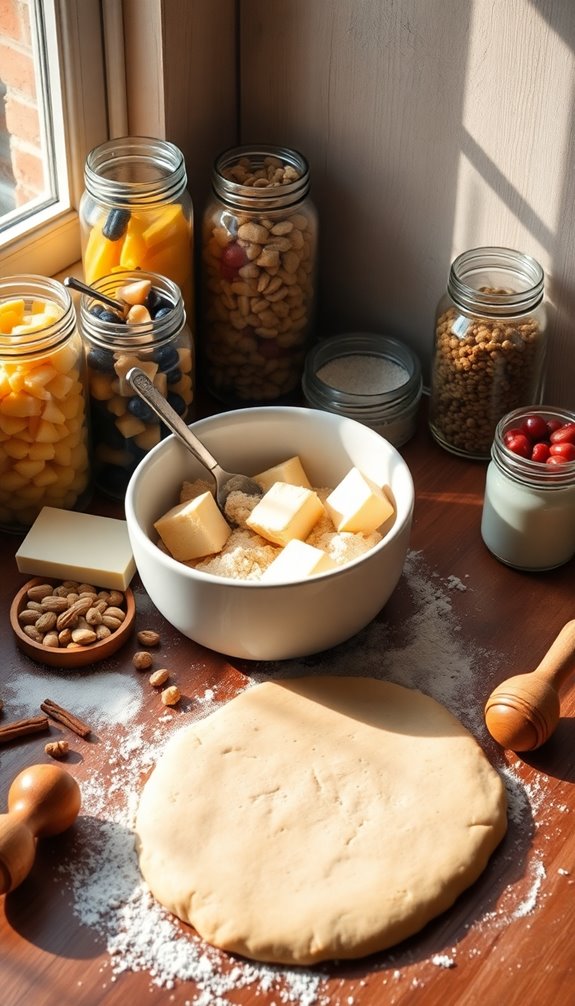
To bake delicious cookies without chocolate chips, start by preheating your oven to 400°F (200°C) and lining your baking sheets with parchment paper.
In a medium bowl, whisk together 2 cups of all-purpose flour, 1 teaspoon of baking powder, and ½ teaspoon of baking soda.
Next, cream 9 tablespoons of room temperature unsalted butter with ¾ cup each of granulated and dark brown sugar until light and fluffy. Consider adding high-protein ingredients to boost nutritional value, such as plant-based protein powder, as these can also help with blood sugar management.
Add in 1 large egg, 1 egg yolk, and 1 tablespoon of pure vanilla extract, mixing until well combined.
Form the cookie dough into balls and chill for 20 minutes to help them maintain shape.
Bake for 8-11 minutes, until the edges are golden and the centers are slightly underbaked for a chewy texture. This method ensures the cookies are soft and chewy while allowing for customization with various flavors or ingredients.
Freezing and Storing Cookie Dough
While baking fresh cookies is a delightful experience, having cookie dough ready to go can make things even easier. You can easily store cookie dough by forming it into balls and freezing them for up to two weeks. To freeze cookie dough, lay the balls on a sheet pan in a single layer to prevent sticking, then transfer them to a freezer-safe bag. Incorporating healthier ingredients can make your frozen cookie dough even more nutritious, such as using nutritious ingredients like oats and nuts for added texture and flavor.
When you're ready to bake, let the frozen dough sit at room temperature for about 10-15 minutes, adding an extra minute to your baking time. For those looking for more variety, consider using gluten-free alternatives in your cookie dough for delightful options.
For longer storage, you can freeze homemade cookies dough for up to three months or refrigerate it for up to 23 days, ensuring you always have fresh cookies on hand.
Flavor Variations and Mix-Ins
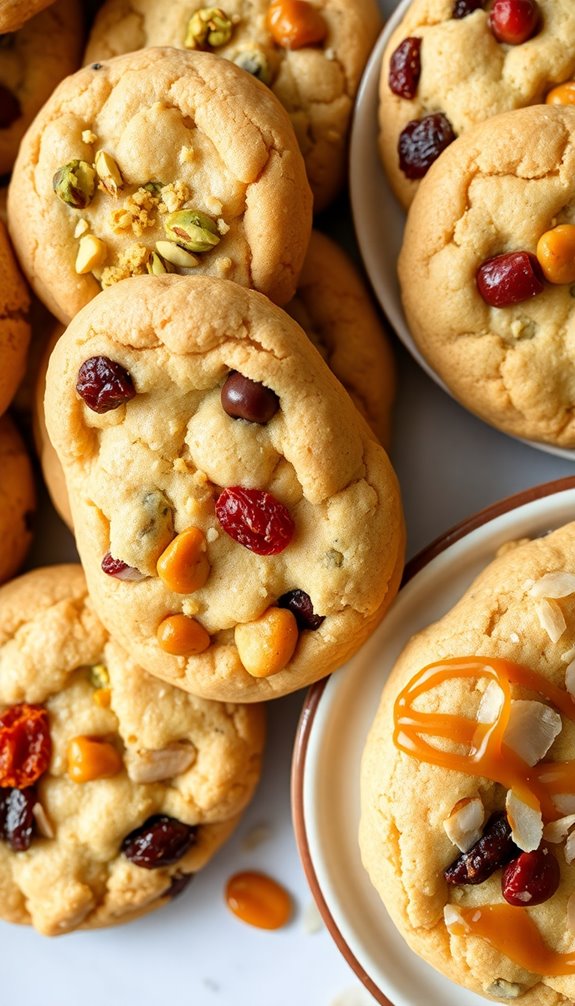
When you're ready to elevate your cookie game, consider exploring various flavor variations and mix-ins that can transform your dough into something extraordinary.
Start by adding nuts like walnuts or pecans for a delightful crunch and enhanced flavor. Dried fruits, such as cranberries or apricots, bring natural sweetness and chewiness, complementing the buttery base beautifully. Incorporating nutrient-dense snacks can also enhance the overall health benefits of your cookies. For example, adding oats and raisins can create a wholesome treat that appeals to children.
Don't forget to sprinkle in some spices; a dash of cinnamon or nutmeg can introduce warm, aromatic notes that elevate your cookies even further.
For a unique twist, consider adding toffee bits or butterscotch chips for a rich, caramel-like flavor. You can also brighten things up with citrus zests from lemon or orange, creating a revitalizing contrast to the sweetness.
Additionally, experimenting with different types of peanut butter can significantly enhance the overall flavor profile of your cookies.
Enjoy experimenting!
Expert Tips for Perfect Cookies
To make your cookies truly stand out, focus on ingredient quality and adjust your baking time as needed.
Temperature control is also key; it can make a big difference in texture and flavor.
With these expert tips, you'll be well on your way to baking the perfect cookie every time.
Ingredient Quality Matters
Ingredient quality plays an essential role in baking perfect cookies, especially when you're skipping the chocolate chips. Using high-quality ingredients like pure vanilla extract and dark brown sugar can greatly enhance your cookies' flavor and richness.
Opt for unbleached all-purpose flour, such as Gold Medal, with a moderate protein content (10.5%) to achieve that perfect chewy texture. Don't forget to use room temperature unsalted butter; it allows for better emulsification when creaming with sugars, resulting in a lighter, fluffier dough.
Freshly cracked eggs at room temperature add moisture and binding, contributing to a tender crumb. Finally, a sprinkle of flaky sea salt before baking elevates the flavor, balancing sweetness and enriching the overall taste experience of your chocolate chipless cookies.
Baking Time Adjustments
High-quality ingredients set the stage for delicious cookies, but baking time is where the magic happens. To achieve the perfect chewy cookie, keep these tips in mind:
- Monitor baking time: Bake at 400°F (200°C) for 8-11 minutes for a gooey texture; longer for a firmer cookie.
- Adjust for size: Smaller cookies may need just 7 minutes, while larger ones might require an extra minute or two.
- Consider your oven: If you're using a convection oven, reduce baking time by 1-2 minutes.
- Chilled dough: If your dough's been chilled for over 30 minutes, add 1-2 minutes to your baking time.
Remove cookies when edges are set and centers are slightly underbaked for that perfect chewy finish!
Temperature Control Techniques
While perfect cookies often start with great ingredients, mastering temperature control is crucial for achieving that ideal chewy texture.
Preheat your oven to the recommended temperature, usually between 350°F to 400°F, to guarantee even baking. An oven thermometer can help verify its accuracy, as incorrect settings might lead to underbaked or overbaked cookies.
Rotate your baking sheets halfway through the baking time to promote even browning and avoid hot spots. Keep a close eye on your cookies; smaller ones can bake quickly. Remove them when the edges are set, and the centers appear slightly underbaked for the best results.
Finally, let them cool on the baking sheet for a few minutes to enhance that chewy texture.
Community Feedback and Reviews
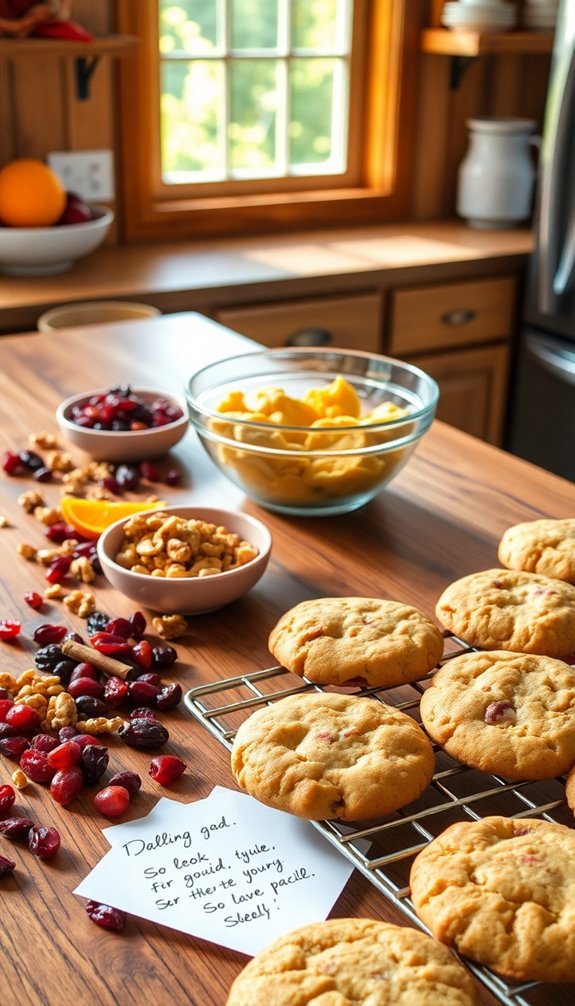
Many bakers have discovered that cookies without chocolate chips can be just as satisfying, if not more so, than their traditional counterparts. Feedback highlights the delightful flavor profile and chewy texture of these tasty treats.
Here are some key points from the community:
- The richness of dark brown sugar and a sprinkle of flaky salt enhance the cookie's taste.
- Many enjoy the chewy chipless chocolate chip experience, noting they remain soft for days.
- Users love the versatility of the recipe, experimenting with nuts or dried fruit.
- Positive discussions often arise around the ease of preparation and successful adaptations.
With so many satisfied bakers, it's clear these cookies are a hit, inviting everyone to join the fun!
Nutritional Information and Considerations
Bakers not only appreciate the delightful flavors of cookies without chocolate chips but also their nutritional aspects. Each cookie typically contains around 187 calories, offering a moderate calorie density.
With 28g of carbohydrates, 2g of protein, and 7g of fat, you should consider these figures when indulging. Using dark brown sugar boosts iron content, enhancing nutritional value.
However, you'll want to note that each cookie has about 5mg of cholesterol and 243mg of sodium, which is important for heart health.
Experimenting with ingredient substitutions like nut butters or adding nuts and dried fruits can increase fiber and healthy fats, making your cookies not just tasty but also a more nutritious option.
Conclusion
As you commence your cookie-making journey, think of your kitchen as a vibrant garden. Each ingredient is a seed, waiting to bloom into a delicious creation. With a sprinkle of creativity and a dash of courage, you'll cultivate delightful chipless cookies that not only satisfy your cravings but also spark joy. Embrace the flavors, experiment with mix-ins, and watch your cookie garden flourish, proving that sweetness can thrive even without chocolate chips. Happy baking!

